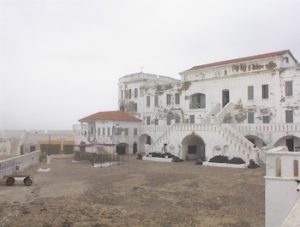
Cape Coast Castle
*On this date in 1653, we affirm the Cape Coast Castle. This was one of about forty "slave castles," or commercial Forts, built by European traders on the Gold Coast of West Africa (now Ghana).
It was initially a Portuguese trading post. However, in 1653, the Swedish Africa Company constructed a timber fort there. It originally was a center for the trade in timber and gold. It was later used in the trans-Atlantic slave trade. Other Ghanaian slave castles include Elmina Castle and Fort Christiansburg. They held enslaved Africans before they were loaded onto ships and sold in the Americas, especially the Caribbean. The fort was the last stop before crossing the Atlantic Ocean.
Hendrik Caerloff, a former Dutch West India Company employee, built the first fort on Cape Coast Castle's present site. As a former high-ranking officer of the Dutch, Caerloff had friendly relations with the local African chiefs, which were necessary to establish a trading post. The first timber lodge was erected at the site in 1653 and named Carolusborg after King Charles X of Sweden. Karloff returned to Europe in 1655. However, Louis de Geer had died in the meantime, and Caerloff got involved in a serious dispute with his heirs.
In Amsterdam, he convinced merchants to give a financial injection to the Danish West India Company, for which he set sail to the Gold Coast in 1657, aiming to capture the Swedish lodges and forts for Denmark. With the help of the Dutch, Caerloff succeeded in driving the Swedes out, leaving the Gold Coast. The King of Fetu prevented the Dutch from taking possession of the fort. After the King died in 1663, the Dutch were finally able to occupy the fort. As the Dutch had captured the former English headquarters and rebuilt it as Fort Amsterdam, Cape Coast became the new capital of the English possessions on the Gold Coast. In 1722, the fort was the site where 54 men of the crew of the pirate Bartholomew Roberts were condemned to death, of whom 52 were hanged and two reprieved. In 1757, during the Seven Years' War, a French naval squadron badly damaged and nearly captured Cape Coast Castle.
This event was likely one of the most important reasons for the restoration of the castle, which was notorious for its collapsing walls and leaking roofs. In 1762, the last remnants of the 17th-century fort were demolished. Greenhill Point, a bastion, was replaced by two new bastions, with a sea gate in the middle. To the south, two new bastions replaced an old round tower as the main defensive work. The tower was extended in the 1790s with two additional stories, which became the governors' apartments. The space below the Bastions was used as the new slave dungeons. The castle and dungeon were first restored in the 1920s by the British Public Works Department.
When Ghana became independent in 1957, the castle came under the care of the Ghana Museums and Monuments Board (GMMB). In the early 1990s, the Ghanaian government restored the building with funds from the United Nations Development Programme (UNDP), the United States Agency for International Development (USAID), technical assistance from the Smithsonian Institution, and contributions from other NGOs. The United Nations Educational, Scientific and Cultural Organization (UNESCO) World Heritage List includes Cape Coast Castle as well as other forts and castles in Ghana.